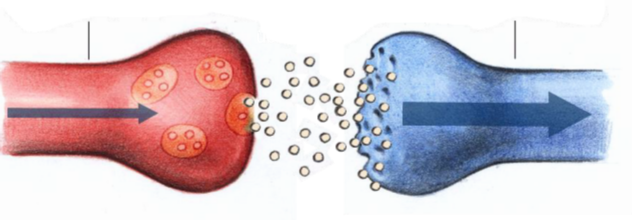Medication: Mechanism of Action
How Antipsychotic Medications Work
Antipsychotic medications are the foundation of schizophrenia treatment. They primarily work by affecting neurotransmitters in the brain.
Key Mechanisms
- Block dopamine receptors (especially D2 receptors)
- Reduce excessive dopamine activity in the mesolimbic system
- Target other neurotransmitters (serotonin, glutamate) depending on the medication
Types of Antipsychotics
- First-generation (typical) - Primarily affect dopamine
- Second-generation (atypical) - Affect both dopamine and serotonin
Explanation Strategy
Use this image to illustrate how antipsychotics create a 'protective shield' that regulates excess dopamine. Explain that the cause of positive symptoms is an excess of dopamine, which leads to overstimulation.


Normal State vs. Dopamine Inhibition
Normal State
In the normal brain, dopamine levels are balanced and regulated appropriately. Dopamine plays important roles in:
- Motivation and reward
- Motor control
- Executive function
- Emotional regulation
In Schizophrenia
There is dysregulation of dopamine, with:
- Excess dopamine activity in the mesolimbic system (associated with positive symptoms)
- Reduced dopamine activity in the mesocortical system (associated with negative/cognitive symptoms)
Dopamine Inhibition by Medication
Antipsychotic medications work by:
- Blocking dopamine receptors in the mesolimbic system
- Reducing positive symptoms like hallucinations and delusions
- Helping normalize brain function
- Different medications have different effects on various dopamine pathways
Medication and Side Effects
Common Side Effects
- Extrapyramidal symptoms - Movement disorders like tremors, stiffness, restlessness
- Metabolic effects - Weight gain, increased blood sugar, cholesterol changes
- Sedation - Drowsiness, fatigue
- Autonomic effects - Dry mouth, blurred vision, constipation
- Sexual dysfunction - Reduced libido, erectile dysfunction
Managing Side Effects
- Dose adjustments
- Switching medications
- Adding medications to counteract side effects
- Lifestyle changes (diet, exercise)
- Regular monitoring of physical health
Important Considerations
- Side effects vary between individuals
- First-generation antipsychotics tend to cause more movement disorders
- Second-generation antipsychotics tend to cause more metabolic effects
- Finding the right medication often requires trial and adjustment
- Benefits of treatment must be weighed against side effects
- Never stop medication without consulting a doctor
Antipsychotic Medications Reference
| Antipsychotic Type | Active Agents | Possible Side Effects |
|---|---|---|
| First Generation | Flupentixol, Haloperidol, Pimozine, Perphenazine | Motor side effects e.g. sitting and movement restlessness (akathisia), muscle stiffness, tremor of the hands |
| Second Generation | Amisulpride, Asenapine, Iloperidone, Lumateperone, Lurasidone, Olanzapine, Paliperidone, Quetiapine, Risperidone, Sertindol, Ziprasidon |
Tiredness, feeling hungry Partly also motor side effects |
| Clozapine | Clozapine | Blood count changes; immune defense no longer working properly. Regular blood count checks necessary. |
| Partial Agonists | Aripiprazol, Brexpiprazol, Cariprazine | Few side effects, but not as effective, rarely used alone. The drugs do not primarily target dopamine receptors. |
| Other | Xanomelin-Trospium | Nausea |
Medication Discussion
When discussing medications, emphasize that different people respond differently to medications and that finding the right medication and dose often requires some trial and adjustment. Encourage participants to discuss specific concerns about medications with their healthcare provider.
Why Psychotherapy?
Complementary to Medication
While medication addresses biological aspects of schizophrenia, psychotherapy addresses:
- Psychological coping strategies
- Social functioning
- Quality of life
- Recovery goals
Benefits of Psychotherapy
- Improved understanding of one's condition
- Enhanced coping skills
- Better medication adherence
- Reduced relapse rates
- Improved social functioning
- Support for recovery goals
Challenges Addressed by Psychotherapy
- Residual symptoms not fully controlled by medication
- Cognitive difficulties
- Social isolation
- Stigma and discrimination
- Family relationships
- Work and educational goals
- Trauma and emotional difficulties
Types of Psychotherapy for Schizophrenia
Cognitive Behavioral Therapy (CBT)
- Focuses on identifying and changing unhelpful thought patterns
- Develops coping strategies for hallucinations and delusions
- Improves problem-solving skills
- Helps distinguish between symptoms and reality
Family Therapy
- Improves family communication
- Reduces high expressed emotion (criticism, hostility, emotional over-involvement)
- Provides education about schizophrenia
- Supports all family members
Localized Information
Describe the different types of psychotherapy, with a focus on the ones available in your area/service. Adapt this section to include the specific therapies that participants can access.
Other Effective Therapies
- Social Skills Training - Improves interpersonal interactions
- Cognitive Remediation - Targets cognitive deficits
- Supportive Psychotherapy - Provides emotional support and guidance
- Group Therapy - Offers peer support and shared learning
- Vocational Rehabilitation - Assists with employment goals
- Integrated Dual Diagnosis Treatment - For co-occurring substance use
Psychosocial Interventions
Comprehensive Approach
Beyond medication and formal psychotherapy, a range of psychosocial interventions can significantly improve outcomes:
Key Interventions
- Case Management - Coordination of services and support
- Supported Housing - Assistance with appropriate living arrangements
- Supported Employment - Help with finding and maintaining work
- Peer Support - Connection with others who have lived experience
- Day Programs - Structured activities and socialization
Resource Information
Describe the different types of psychosocial interventions, with a focus on the ones available in your area/service. Consider involving a social worker to provide specific information about local resources.
Benefits of Psychosocial Interventions
- Reduced hospitalization rates
- Improved quality of life
- Enhanced social integration
- Greater independence
- Meaningful community participation
- Development of natural support systems
- Recovery-oriented approach